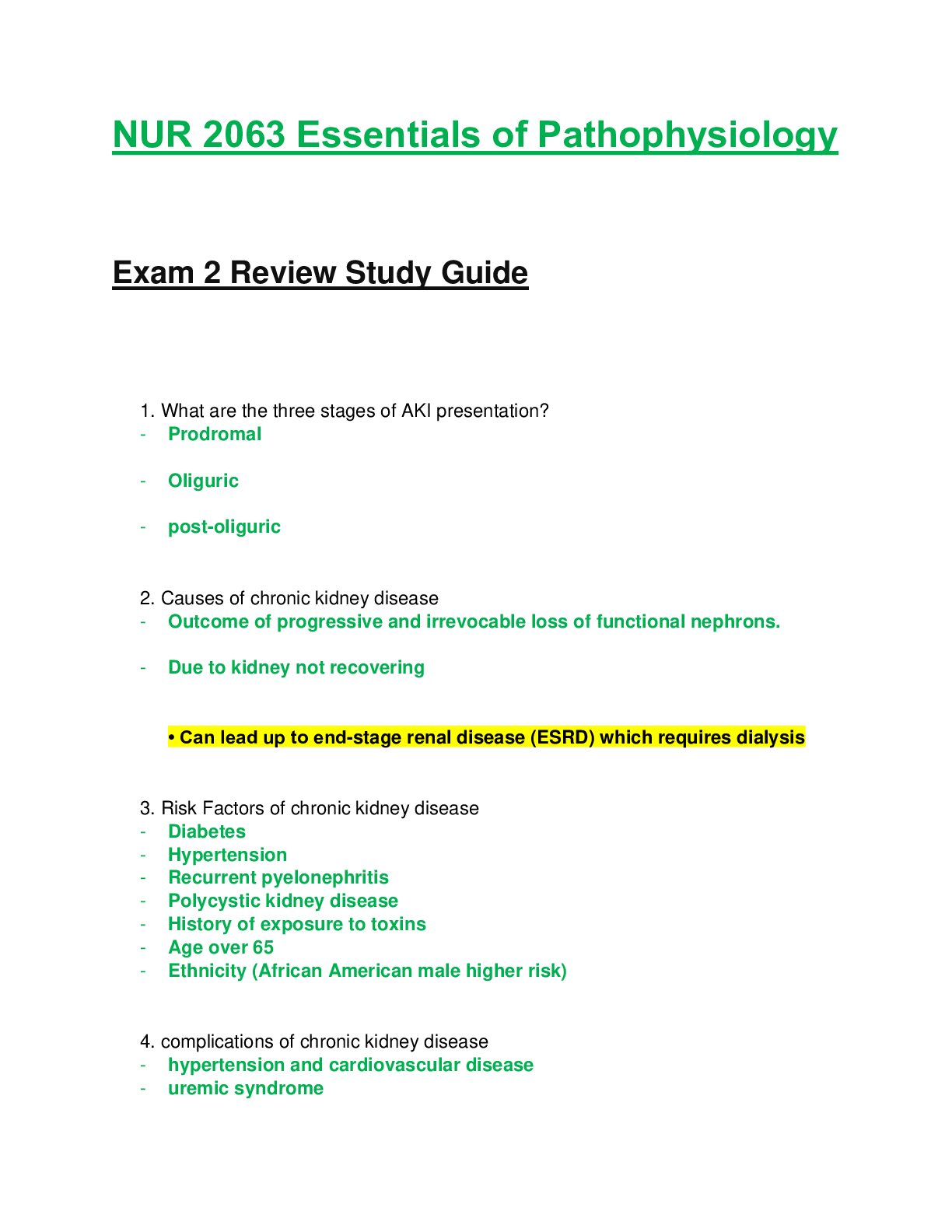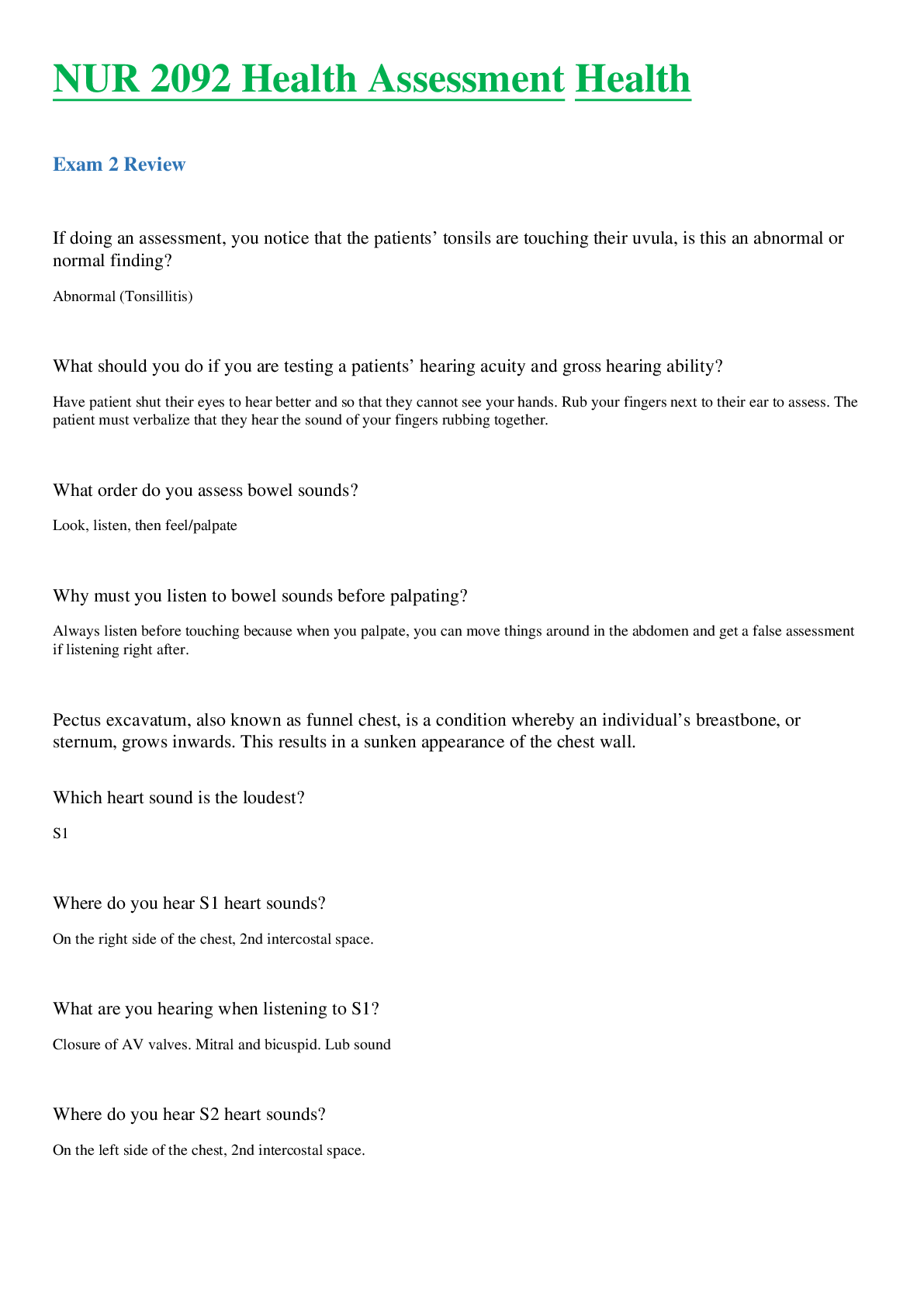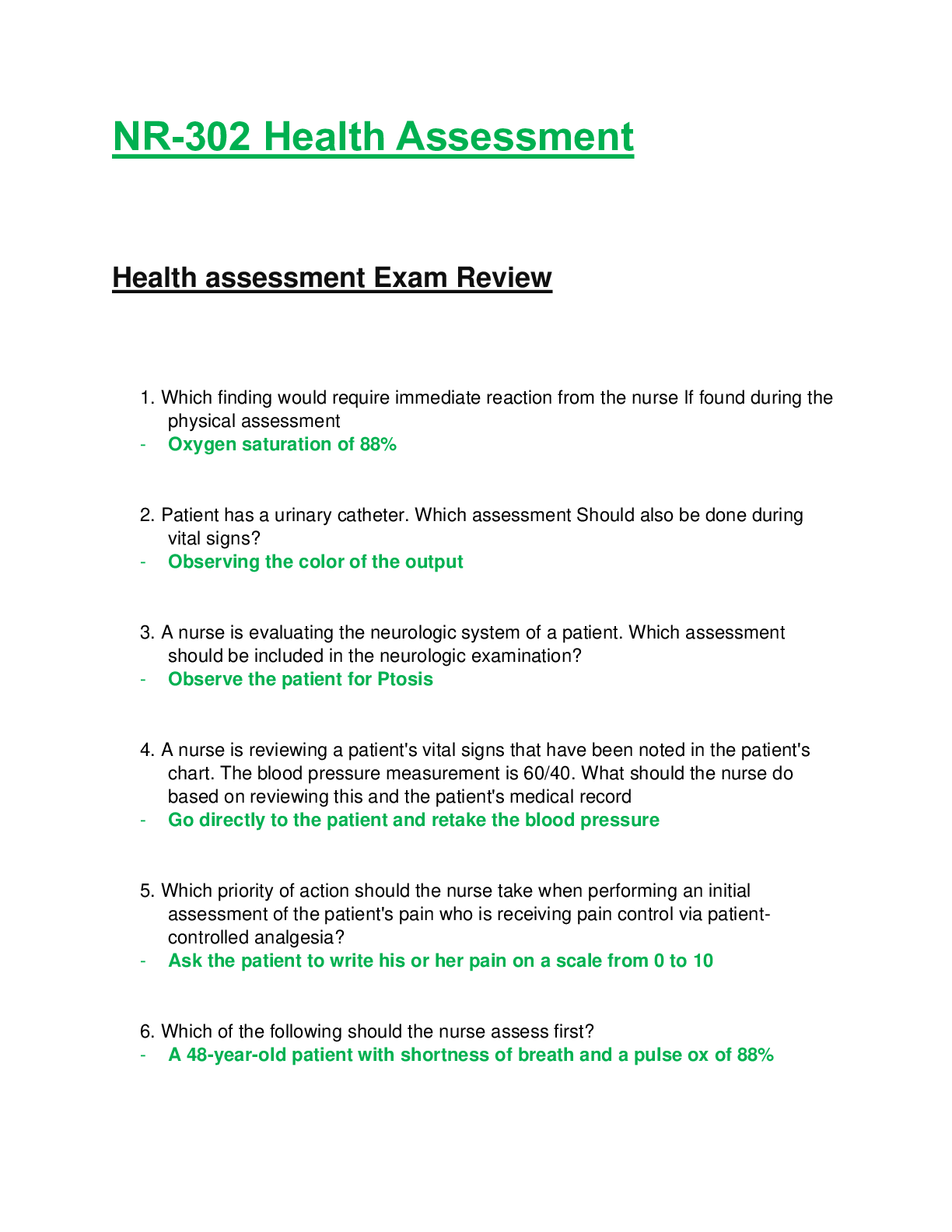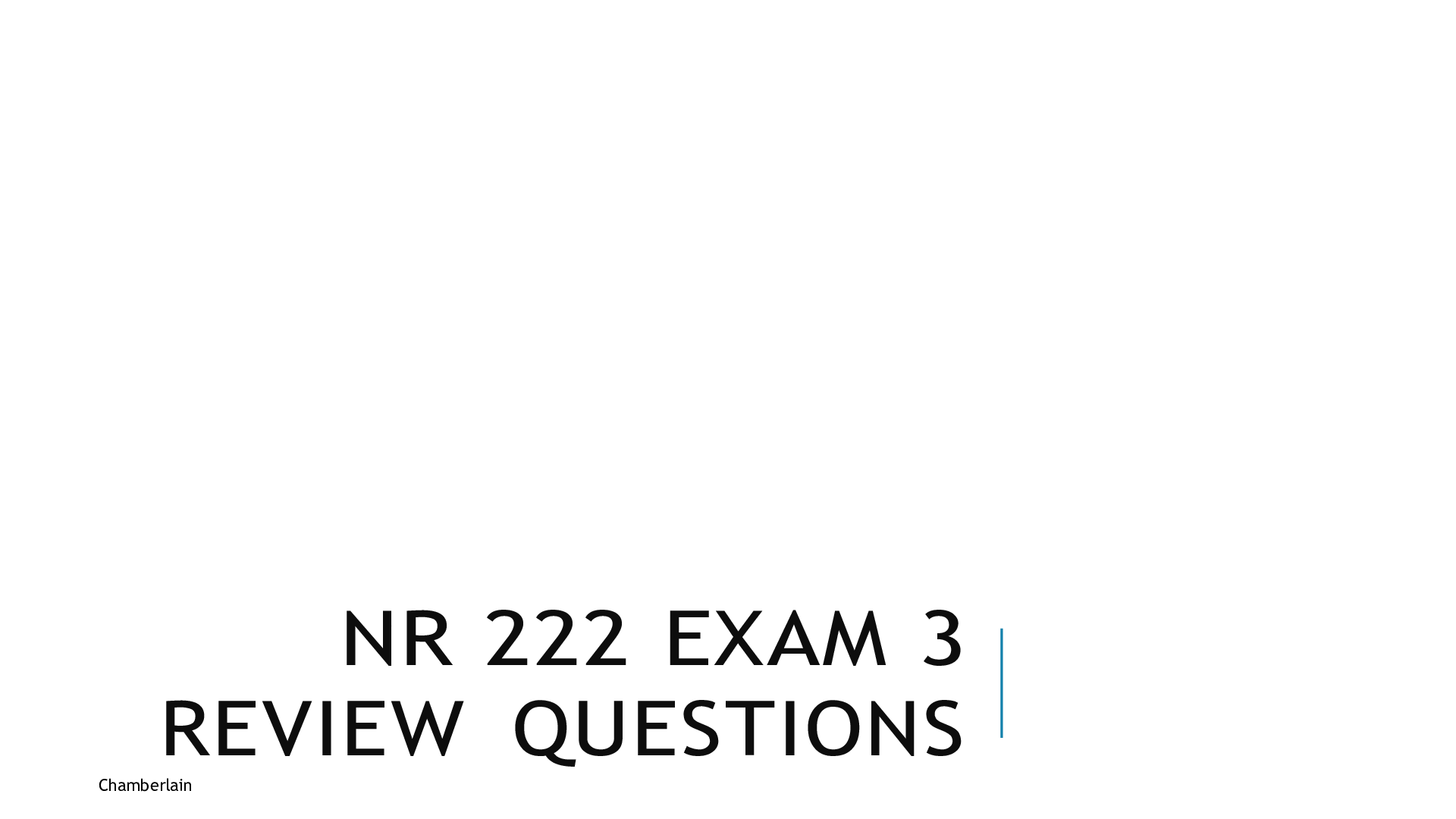*NURSING > EXAM REVIEW > NR222 / NR 222: Health & Wellness Exam 2 Review Latest Update Chamberlain College of Nursing (All)
NR222 / NR 222: Health & Wellness Exam 2 Review Latest Update Chamberlain College of Nursing
Document Content and Description Below
NR-222 Health & Wellness Exam 2 Review Answer = (Green, Bold) Rationale = (Yellow) 1. A 6-month-old child from Guatemala was adopted by an American family in Indiana. The child's socializa... tion into the American midwestern culture is best described as: A. Assimilation. B. Acculturation. C. Biculturalism. D. Enculturation. 2. A 46-year-old woman from Bosnia came to the United States 6 years ago. Although she did not celebrate Christmas when she lived in Bosnia, she celebrates Christmas with her family now. This woman has experienced assimilation into the culture of the United States because she: A .Chose to be bicultural. B. Adapted to and adopted the American culture. C. Had an extremely negative experience with the American culture. D. Gave up part of her ethnic identity in favor of the American culture. 3. To enhance their cultural awareness, nursing students need to make an in-depth self-examination of their own: A. Motivation and commitment to caring. B. Social, cultural, and biophysical factors. C. Engagement in cross-cultural interactions. D. Background, recognizing her biases and prejudices. 4. Which of the following is required in the delivery of culturally congruent care? A. Learning about vast cultures B. Motivation and commitment to caring C. Influencing treatment and care of patients D. Acquiring specific knowledge, skills, and attitudes 5. A registered nurse is admitting a patient of French heritage to the hospital. Which question asked by the nurse indicates that the nurse is stereotyping the patient? A. "What are your dietary preferences?" B. "What time do you typically go to bed?" C. "Do you bathe and use deodorant more than one time a week?" D. "Do you have any health issues that we should know about?" 6. When action is taken on one's prejudices: A. Discrimination occurs. B. Delivery of culturally congruent care is ensured. C. Effective intercultural communication develops. D. Sufficient comparative knowledge of diverse groups is obtained. 7. A nursing student is doing a community health rotation in an inner-city public health department. The student investigates sociodemographic and health data of the people served by the health department, and detects disparities in health outcomes between the rich and poor. This is an example of a(n): A. Illness attributed to natural and biological forces. B. Creation of the student's interpretation and descriptions of the data. C. Influence of socioeconomic factors in morbidity and mortality. D. Combination of naturalistic, religious, and supernatural modalities. 8. Culture strongly influences pain expression and need for pain medication. However, cultural pain is: A. Not expressed verbally or physically. B. Expressed only to others from a similar culture. C. Usually more intense than physical pain. D. Suffered by a patient whose valued way of life is disregarded by practitioners. 9. Which of the following best represents the dominant values in American society on individual autonomy and self-determination? A. Physician orders B. Advance directive C. Durable power of attorney D. Court-appointed guardian 10. The nurse at an outpatient clinic asks a patient who is Chinese American with newly diagnosed hypertension if he is limiting his sodium intake as directed. The patient does not make eye contact with the nurse but nods his head. What should the nurse do next? A. Ask the patient how much salt he is consuming each day B. Discuss the health implications of sodium and hypertension C. Remind the patient that many foods such as soy sauce contain "hidden" sodium D. Suggest some low-sodium dietary alternatives 11. A female Jamaican immigrant has been late to her last two clinic visits, which in turn had to be rescheduled. The best action that the nurse could take to prevent the patient from being late to her next appointment is: A. Give her a copy of the city bus schedule. B. Call her the day before her appointment as a reminder to be on time. C. Explore what has prevented her from being at the clinic in time for her appointment. D. Refer her to a clinic that is closer to her home. 12. A nursing student is taking postoperative vital signs in the postanesthesia care unit. She knows that some ethnic groups are more prone to genetic disorders. Which of the following patients is most at risk for developing malignant hypertension? A. Ashkenazi Jew B. Chinese American C. African American D. Filipino 13. A community health nurse is making a healthy baby visit to a new mother who recently emigrated to the United States from Ghana. When discussing contraceptives with the new mom, the mother states that she won't have to worry about getting pregnant for the time being. The nurse understands that the mom most likely made this statement because: A. She won't resume sexual relations until her baby is weaned. B. She is taking the medroxyprogesterone (Depo-Provera) shot. C. Her husband was recently deployed to Afghanistan. D. She has access to free condoms from the clinic. 14. During their clinical post-conference meeting, several nursing students were discussing their patients with their instructor. One student from a middle-class family shared that her patient was homeless. This is an example of caring for a patient from a different: A. Ethnicity. B. Culture. C. Heritage. D. Religion. 15. When interviewing a Native American patient on admission to the hospital emergency department, which questions are appropriate for the nurse to ask? (Select all that apply.) A. Do you use any folk remedies? B. Do you have a family physician? C. Do you use a Shaman? D. Does your family have a history of alcohol abuse? 16. The patient for whom you are caring needs a liver transplant to survive. This patient has been out of work for several months and doesn't have health insurance or enough cash. What principles would be a priority in a discussion about ethics? A. Accountability because you as the nurse are accountable for the well-being of this patient B. Respect for autonomy because this patient's autonomy will be violated if he does not receive the liver transplant C. Ethics of care because the caring thing that a nurse could provide this patient is resources for a liver transplant D. Justice because the first and greatest question in this situation is how to determine the just distribution of resources 17. The point of the ethical principal to "do no harm" is an agreement to reassure the public that in all ways the health care team not only works to heal patients but agree to do this in the least painful and harmful way possible. Which principle describes this agreement? A. Beneficence B. Accountability C. Nonmaleficence D. Respect for autonomy 18. A child's immunization may cause discomfort during administration, but the benefits of protection from disease, both for the individual and society, outweigh the temporary discomforts. Which principle is involved in this situation? A. Fidelity B. Beneficence C. Nonmaleficence D. Respect for autonomy 19. When a nurse assesses a patient for pain and offers a plan to manage the pain, which principal is used to encourage the nurse to monitor the patient's response to the pain? A. Fidelity B. Beneficence C. Nonmaleficence D. Respect for autonomy 20. What is the best example of the nurse practicing patient advocacy? A. Seek out the nursing supervisor in conflicting procedural situations B. Document all clinical changes in the medical record in a timely manner C. Work to understand the law as it applies to an error in following standards of care D. Assess the patient's point of view and prepare to articulate it 21. Successful ethical discussion depends on people who have a clear sense of personal values. When a group of people share many of the same values, it may be possible to refer for guidance to philosophical principals of utilitarianism. This philosophy proposes which of the following? A. The value of something is determined by its usefulness to society. B. People's values are determined by religious leaders. C. The decision to perform a liver transplant depends on a measure of the moral life that the patient has led so far. D. The best way to determine the solution to an ethical dilemma is to refer the case to the attending physician or health care provider. 22. The philosophy sometimes called the ethics of care suggests that ethical dilemmas can best be solved by attention to which of the following? A. Patients B. Relationships C. Ethical principles D. Code of ethics for nurses 23. In most ethical dilemmas in health care, the solution to the dilemma requires negotiation among members of the health care team. Why is the nurse's point of view valuable? A. Nurses understand the principle of autonomy to guide respect for patient's self-worth. B. Nurses have a scope of practice that encourages their presence during ethical discussions. C. Nurses develop a relationship to the patient that is unique among all professional health care providers. D. The nurse's code of ethics recommends that a nurse be present at any ethical discussion about patient care. 24. Ethical dilemmas often arise over a conflict of opinion. What is the critical first step in negotiating the difference of opinion? A. Consult a professional ethicist to ensure that the steps of the process occur in full. B. Gather all relevant information regarding the clinical, social, and spiritual aspects of the dilemma. C. Ensure that the attending physician or health care provider has written an order for an ethics consultation to support the ethics process. D. List the ethical principles that inform the dilemma so negotiations agree on the language of the discussion. 25. The ANA code of nursing ethics articulates that the nurse "promotes, advocates for, and strives to protect the health, safety, and rights of the patient." This includes the protection of patient privacy. On the basis of this principal, if you participate in a public online social network such as Facebook, could you post images of a patient's x-ray film if you deleted all patient identifiers? A. Yes because patient privacy would not be violated as long as the patient identifiers were removed B. Yes because respect for autonomy implies that you have the autonomy to decide what constitutes privacy C. No because, even though patient identifiers are removed, someone could identify the patient based on other comments that you make online about his or her condition and your place of work D. No because the principal of justice requires you to allocate resources fairly 26. When an ethical dilemma occurs on your unit, can you resolve the dilemma by taking a vote? A. Yes because ethics is essentially a democratic process, with all participants sharing an equal voice B. No because an ethical dilemma involves the resolution of conflicting values and principals rather than simply the identification of what people want to do C. Yes because ethical dilemmas otherwise take up time and energy that is better spent at the bedside performing direct patient care D. No because most ethical dilemmas are resolved by deferring to the medical director of the ethics department 27. Resolution of an ethical dilemma involves discussion with the patient, the patient's family, and participants from all health care disciplines. Which of the following describes the role of the nurse in the resolution of ethical dilemmas? A. To articulate his or her unique point of view, including knowledge based on clinical and psychosocial observations B. To await new clinical orders from the physician C. To limit discussions about ethical principals D. To allow the patient and the physician to resolve the dilemma without regard to personally held values or opinions regarding the ethical issues 28. A precise definition for the word quality is difficult to articulate when it comes to quality of life. Why? (Select all that apply.) A. Quality of life is measured by potential income, and average income varies in different regions of the country. B. Community values are subject to change, and communities influence definitions of "quality." C. Individual experiences influence perceptions of quality in potentially different ways, making consensus difficult. D. Placing measurable value on elusive elements such as cognitive skills, ability to perform meaningful work, and relationship to family is challenging. 29. Which of the following explain how health care reform is an ethical issue? (Select all that apply.) A. Access to care is an issue of beneficence, a fundamental principal in health care ethics. B. Reforms promote the principle of beneficence, a hallmark of health care ethics. C. Purchasing health care insurance may become an obligation rather than a choice, a potential conflict between autonomy and beneficence. D. Lack of access to affordable health care causes harm, and nonmaleficence is a basic principal of health care ethics. 30. Which is the best method of negotiating or processing difficult ethical situations? A. Ethical issues arise between dissenting providers and can be best resolved by deference to an independent arbitrator such a chaplain. B. Since ethical issues usually affect policy and procedure, a legal expert is the best consultant to help resolve disputes. C. Institutional ethics committees help to ensure that all participants involved in the ethical dilemma get a fair hearing and an opportunity to express values, feelings, and opinions as a way to find consensus. D. Medical experts are best able to resolve conflicts about outcome predictions. 31. The increasing number of ethnic groups in the United States has been influenced by what? A. Communicable diseases in disadvantaged countries B. Increasing immigration C. Homelessness D. Healthcare reform 32. The nurse recognizes that a minority group is perceived as: A. capturing biological variations within human populations. B. people who receive less than their share of wealth, power, or social status. C. people set apart on the basis of cultural or national origin characteristics. D. socially organized groups with salient differences with respect to other groups in society. 33. Which of the following diseases are Arab Americans at the highest risk for? A. colon cancer. B. hypertension. C. adult-onset diabetes. D. end-stage renal disease. 34. Priority nursing assessments of Asian Americans/Pacific Islanders should be on which disease process? A. COPD B. Hypertension C. Diabetes mellitus D. Breast cancer 35. Priority nursing assessments of Latino/Hispanic Americans should focus on what disease process, because of its higher incidence in this population? A. Cancer B. Stroke C. Diabetes D. Cardiovascular 36. What two groups comprise emerging populations in the United States? (select two that apply) A. Older Americans B. Ethnic minorities C. Homeless D. Baby boomers 37. Which of the following statements accurately describe race and ethnic categories in the United States as defined by the Office of Management and Budget? (select all that apply) A. Race and ethnicity have the same definition. B. Ethnicity is associated with power and indexes the history or ongoing imposition of one group's authority above another. C. Ethnicity focuses on differences in meaning, values, and ways of living. D. Ethnicity refers to commonalities in language, history, nation, or region of origin. E. A minority group consists of people living in society that is usually disadvantaged. 38. Ethnicity is evident in customs of particular groups. Which of the following statements accurately reflect the definitions of culture, values and value orientation? (select all that apply) A. Culture refers to patterns of human behavior that include language, communication, customs and beliefs. B. Ethnicity is shaped by values, beliefs, norms, and practices that are shared by members of the same group. C. Health care beliefs and attitudes among ethnic groups are congruent with health care providers. D. Values are beliefs about the worth of something and serve as standards that influence behavior. E. Value orientations reflect the personality type of a particular society. 39. Which of the following statements are true about cultural competency in health care? (select all that apply) A. Recognizing and accepting cultural diversity achieves cultural competency. B. Cultural competency is a major element in eliminating health disparities. C. There is no association between the care recipient's cultural background and the health care providers' cultural beliefs. D. Health care services are to be provided that are respectful of and responsive to the diverse health beliefs of the care recipient. E. Health care providers must be aware of how people interpret their health issues or illnesses. 40. Nurses caring for the Black/African American population need to maintain an awareness of which of the following health-related cultural aspects of care? (select two that apply) A. Severe high blood pressure is more common for African Americans. B. Cancer and mortality rates for African Americans is higher than that for White Americans. C. African Americans are less likely to be diagnosed with diabetes. D. African Americans have the highest percentage of women with low or no prenatal care in the first trimester. 41. Which nursing intervention would be based upon utilitarian theory? A. Initiating resuscitation of a 20-week gestation newborn B. Preparing a 52-year-old woman with uterine cancer for a hysterectomy C. Placing a 92-year-old client with terminal congestive heart failure on a ventilator D. Administering chemotherapy to a 17-year-old with leukemia who states that he wants everything terminated 42. The nurse recognizes that the American Nurses Association (ANA) Code of Ethics identifies expectations of ethical behavior through statements regarding: A. the primary goals, values, and obligations of the profession. B. specific standards of care for selected populations. C. disciplinary actions for incompetent nursing practice. D. legal standards of practice. 43. Which statement supports the principle of beneficence that overrides a person's autonomy? A. The nurse presses the button to administer pain medication through a patient-controlled analgesia (PCA) infusion. B. The nurse maintains confidentiality to an HIV-positive husband who does not want his wife informed of his HIV status. C. The nurse instructs parents that their newborn must be placed in a car seat that faces the back of the seat in the back seat of the car. D. The nurse counsels a 21-year-old woman delivering her third child that she should request a tubal ligation. 44. Which of the following statements best supports the ethical principle of justice? A. Access to health care should be provided for all people. B. Dialysis should be available for clients who adhere to their prescribed dietary regimes. C. Transplant organs should be allocated based on ability to pay for hospital costs. D. Health-promotion interventions should be provided to those who agree to pay more for health services. 45. When a nurse utilizes aggressive action on behalf of a care recipient, he or she is considered to be practicing: A. social justice. B. advocacy. C. moral agency. D. assertiveness. 46. In health promotion settings, individual autonomy may be limited by: A. freedom of action. B. freedom of speech. C. the duty of protecting the health and safety of society. D. public policy. 47. Which of the following statements accurately describe ethical theories? (Select all that apply) A. Normative theories are concerned with ensuring good actions. B. Descriptive theories tell us what actions to take. C. Consequentialist theories hold that decisions should take into account all knowable potential consequences. D. Religions and duty-based theories assert that certain duties will produce good outcomes. E. Descriptive theories are directive. 48. What are some of the definitions that support using the term profession to denote the status of nursing? (select all that apply) A. Nursing is considered a profession because it provides a service to society. B. Nursing is considered a profession because of the stable employment opportunities. C. Nursing is self-governing. D. Members of the nursing profession are accountable for their actions. E. Members of a profession abide by a code of ethics. 49. In health-promotion activities, which of the following statements is accurate regarding respect for autonomy? (select all that apply) A. Individuals must be given the information they need to make choices. B. Choices are autonomous when public policy dictates the action. C. Autonomous choices are made when the person can understand the risks and benefits of the choices. D. Autonomous choices are acceptable even when mental capacity is questionable. E. Choices are considered autonomous in the absence of coercive influence. 50. The nurse participates in the process of ethical inquiry in health promotion to: (select all that apply) A. facilitate in-depth data gathering. B. resolve all ethical problems related to health promotion. C. understand what is expected of the health-promotion agent viewed as a moral agent. D. gain clarity on actual or potential issues regarding health-promotion endeavors. E. foresee all possible consequences of ethical issues related to health promotion. F. permit the uncovering of hidden agendas and interests. G. focus on salient aspects of problems, thus enhancing professional judgment. [Show More]
Last updated: 2 years ago
Preview 1 out of 12 pages

Buy this document to get the full access instantly
Instant Download Access after purchase
Buy NowInstant download
We Accept:

Reviews( 0 )
$10.00
Can't find what you want? Try our AI powered Search
Document information
Connected school, study & course
About the document
Uploaded On
Nov 10, 2020
Number of pages
12
Written in
Additional information
This document has been written for:
Uploaded
Nov 10, 2020
Downloads
0
Views
205


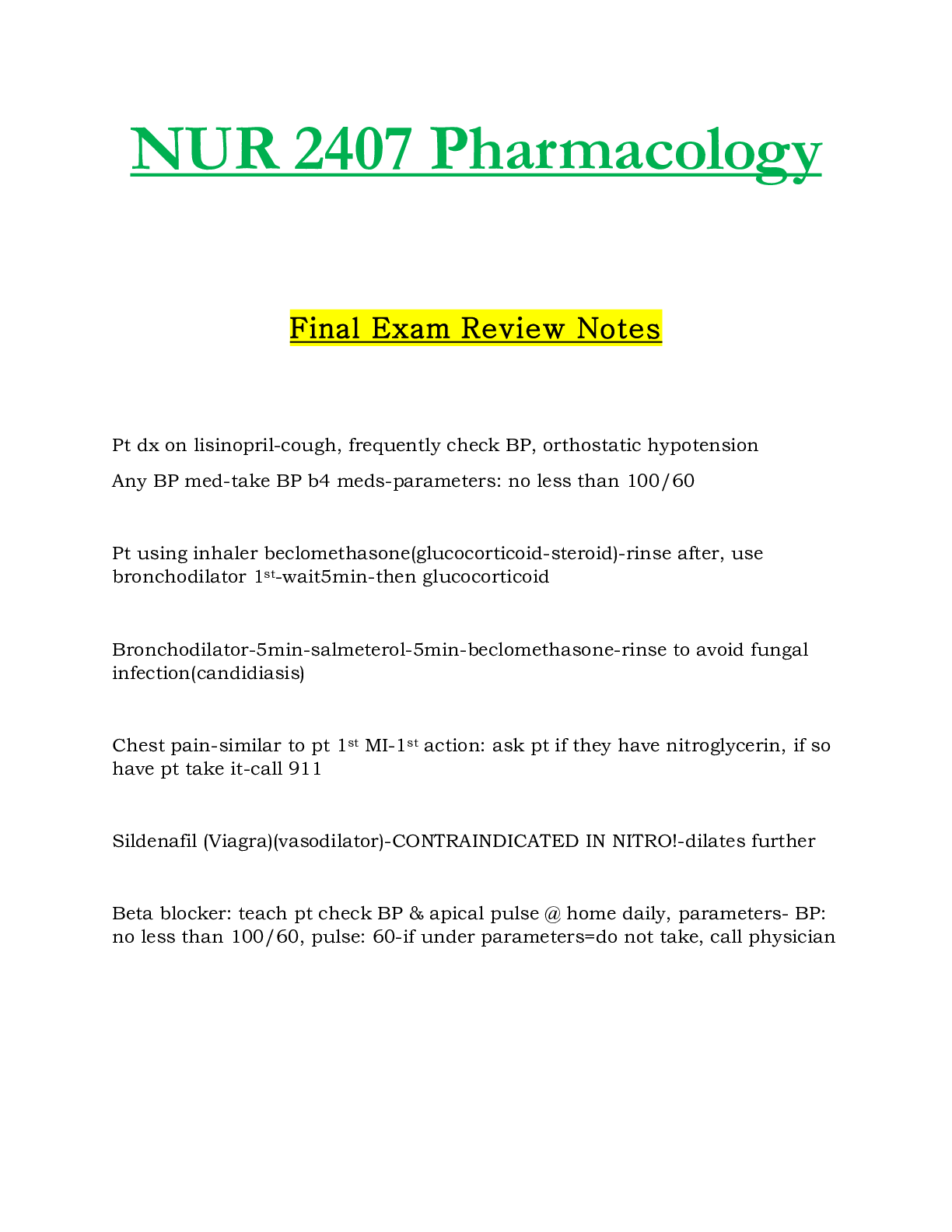
 JY21.png)










